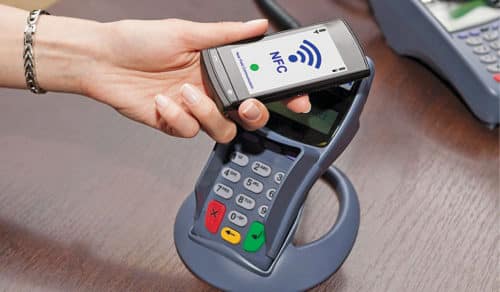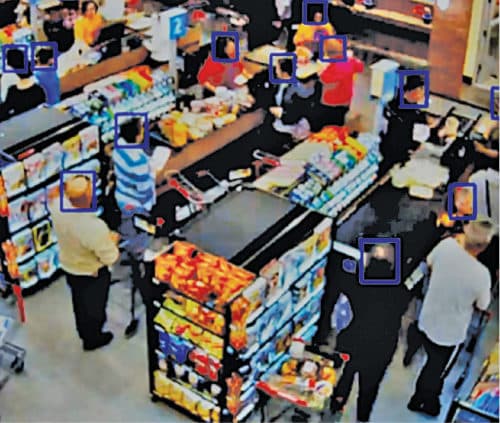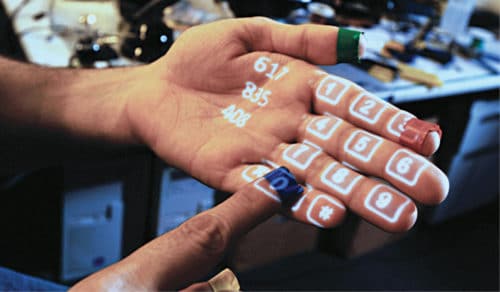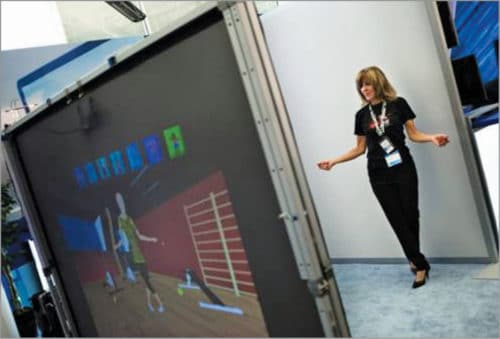Retailers are starting to acknowledge the role of IT as an enabler. Basically, it can speed up processes and deliver cost-saving benefits to companies

You are out for an evening stroll in the market. One of your shirt’s fancy button breaks and rolls out of sight. You enter a big apparel retail store and allow one of the robots to scan another shirt button. The robot walks you to the right shelf where you are able to locate the exact same button.
You probably did not notice the beeping sound when you walked into the store—it was the thermal crowd management non-intrusive sensor installed at the front door that detected your body heat, recorded your entry and added you as a customer into the customer-tracking system.
As you walk out, you notice fur coats in four different designs. You tell the store robot that you would like to try all four. The robot’s screen displays the product codes and leads you to a high-tech mirror. Its parametric technology simulates your body type based on your weight, height and measurements, and one by one shows how you would look in each coat. Then, it simultaneously shows you all your pictures in each of the four fur coats so you can compare and decide which one you want to buy.
You walk out of the store with the most appealing coat, and the money is automatically debited by an app installed on your phone.
This is not a scene out of some science fiction book but a retail experience you can look forward to in the future.
With increasing internationalisation of retailing, both in terms of points-of-sale and points-of-supply, investment in IT in the retail sector is significantly increasing. IT is playing an ever more imperative role in the management of complex retail operations. Today, retailers are transforming their IT capabilities for many reasons, such as to augment the company’s capability to respond to the evolving marketplace via greater speed and flexibility, to collect and analyse customer data while enhancing segregation and to work more effectively, as retailers require a single system operating across stores (or even across countries) to make the most effective use of inventory and enhance business processes.
Emerging technologies such as augmented reality (AR), near field communication (NFC), smart shopping devices and SixthSense are making way for novel and highly interactive customer touch points. These technologies are developing at a rapid speed and throwing complex challenges at retailers. While some touch points have been adopted, many are still in beta stage.

Application of NFC technology in the retail sector
NFC technology is now accessible on most smartphones. Also, cheap NFC tags can be simply added to any physical object to turn it into an interactive experience. For example, Adidas Canada used the technology before opening its Originals store in Vancouver. Followers of the brand’s adidasCA Twitter account were invited to a covert location to get an NFC-enabled Hype Key Card on first-come, first-serve basis and sign up for the chance to win a limited-edition pair of shoes.
When the store opened its shutters, Hype Key Card holders were invited to tap their cards at the counter to check if they had been lucky enough to bag any prize. Hence, the creative campaign not only attracted customers into the outlet, it also created a social media buzz about its opening and improved customer engagement.
Today, brick-and-mortar stores are in cut-throat competition with online stores. This makes physical customer engagement critical for offline stores. In 2016, a Timberland store in New York gave its customers an NFC-enabled tablet to scan tagged products to view product information and recommendations. At the end of the shopping experience, they could then send themselves a dream-list of products they loved by email.
NFC technology is also a key motivating force behind the quick rise in digital wallet payments such as Google Pay and Apple Pay. Mobile payments are fast, simple and handier. Moreover, the fact that NFC payments do not need biometric features, such as fingerprint scans, makes them even more secure vis-a-vis chip and PIN.
Faster payments mean shorter queues at the billing section, so employees have more time for store operations and customer service. Conventional card-based loyalty schemes can incentivise consumers but are not very helpful in impacting customer behaviour. Rather, stores can use NFC tech to develop a frictionless and engaging loyalty scheme that motivates customers to be more loyal.
British sushi chain Wasabi used Thyngs technology to create an app-free loyalty scheme that lets customers tap a smart card with their phone to join Wasabi Club and collect loyalty points in-store.
NFC technology can also be used as a simple and novel way for retailers to get immediate customer opinion. Shoppers can be asked to provide service feedback by tapping NFC chips on lanyards worn by in-store staff. UK-based Asian fast-food chain Wagamama used Thyngs-enabled smart cards when trying out its new MA MA menu at its South Bank branch in London. Wannabe tasters were able to test some of the new menu items on complimentary basis and then rate their dish by just tapping their phone on a smart card.
Thyngs platform then lets retail stores to monitor any such engagement in real time, supplying comprehensive analytics on how effective their marketing strategies are. Such insights are generally not viable for offline marketing campaigns.
Smart shopping carts
Smart shopping devices that are likely to be widely used in the near future are being developed by technology leaders including IBM, NCR, Fujitsu and Hewlett-Packard. One such device is a supermarket smart cart that has a screen embedded in its handles. A shopper simply needs to swipe a smart card through a slot in the cart to trigger the device on. The screen then communicates with the customer and alerts him or her of various in-store deals and promotions.
Data with respect to customer purchase history is also maintained, and this enables the cart to anticipate which direction the customer is likely to move on the retail shop floor. Customised suggestions then begin to pop up on screen, to help and aid the shopper. The cart maintains a track of all products kept inside it. This means much shorter queues at the billing section as the cart can communicate with the cash register.
Thermal imaging
Thermal imaging cameras operate in the infrared (IR) range of the electromagnetic spectrum (roughly 9000 to 14,000 nanometres, or 9µm to 14µm) and generate images of that radiation, known as thermograms. Every object emits IR radiation, which is more than absolute zero, and quantum of radiation emitted by an object goes up as its temperature increases.

It is a well-known fact that temperature of human beings is higher than most objects in the environment. On this basis, thermography is used to detect and count the number of humans. Large retail stores can deploy array sensors that detect heat sources in thermal imaging systems.
These systems are generally based on embedded technology and are placed at a height for precise results. Since these systems detect heat emitted by people, they are able to count well even in varying intensity of lighting. Moreover, they do not need to employ complex background removal algorithms, which is a pre-requisite for computer vision systems. This results in a more precise individual human count. However, such systems are likely to fail in cold weather when customers are wearing thick woollens that help in insulating their body heat.
People counters help in generating actionable customer insights and analytics from such useful data points as footfall, path customers take when moving inside a store, time of the day customers enter the store and so on.
This technology can also help in measuring customer reactions to in-store promotions as well as price changes, and also make linkages between footfall and sales. Information and insights ultimately contribute towards improving store layouts and quality of service.
SixthSense technology
Indian computer scientist and inventor Pranav Mistry’s videos wherein he showcases SixthSense technology are very popular. Developed by MIT Media Lab’s Fluid Interfaces Group, the tech is a wearable gestural interface that augments the physical world around us with digital information. The prototype is a combination of a computer and cellphone. It encompasses a pocket projector, mirror and camera. Hardware elements are integrated into a pendant-like mobile wearable device connected to the cellphone of the customer.

This technology enables shoppers in retail outlets to communicate with the packaging of the products kept on shelves. Usually, while shopping for a big-ticket item, such as a high-end notebook or car, customers refer to sites that provide product reviews, comparisons between closely-competing products, etc.
However, such homework is generally not done for low-value items such as books, music, CDs, etc, as these are bought more impulsively. Using Sixth Sense technology, all a shopper needs to do is scan the product bar code and a lot of product-related information such as reviews, comparisons and the like is projected on any chosen surface.
This also allows retail outlets to save a lot of inventory space (and money) by stocking only one or few samples of different products and offer next day delivery—in case customers choose and buy the product via barcode scanning using a cellphone. This technology gives rise to creative convenience—imagine, the barcode on a box of tissue paper flashing a green light on scanning to denote eco-friendliness.
Augmented reality
AR adds a visual layer of information on top of such surfaces as a mirror, and the content interacts with layers of information provided by the real world. It is an increasingly popular technology wherein advancements are happening at a rapid pace. For example, by holding up a specially-coded box or label to a webcam-equipped computer, a user can see an augmented, 3D image of the product, or a graphic display of other additional information. Intel has developed a high-tech mirror that enables a shopper to see how the chosen clothes would look on him or her.

It is a digital trial room where the customer just needs to stand in front of an LCD monitor, and parametric technology simulates body type and displays how garments fit, based on weight, height and other measurements.
Malls of the future could use digital signage that delivers targeted advertising and also captures key customer demographic information via video for analysis later, thus creating almost-real-time customer feedback.
Major consumer product companies are also testing the business value of mobile mashups. Bionic Eye is an iPhone app wherein the user can point the camera at a mall to get a screen display of all outlets inside the building. Virtual signposts with directions to nearby points of interest are also included. And all this works offline.
Data mining and predictive analytics
You push your cart full of goodies to the cash register at the department store. Bar code of each product is transmitted one by one to the computer and all transactional data is saved in your folder. You have been assigned a customer ID number and asked to fill a brief form that requires details like your age, gender, income, occupation, email ID, etc. A few days later you receive an email from the store informing you about some attractive offers on shoes. Till now you have been buying only shoe accessories such as socks and shoe polish, among other things. This is data mining at work.
Big Data, a term much in vogue today, refers to the deployment of huge amounts of information to make businesses more efficient and responsive to clients and customers. Data is collected and mined in a number of sectors, more so, retail, telecom and finance. However, the retail sector has the highest level of interaction with a huge volume of customers from different walks of life and, hence, retailers are very interested in understanding their customers as closely as they possibly can.
Imagine you login to your favourite e-commerce site to buy, say, a handset, and shortlist one and put it in your virtual shopping cart. However, you read customer reviews and end up changing your mind. You then discover that every online store that you visit features an ad for that very handset. This happens as online retailers can give you a virtual ID number and track your journey from site to site, and purchase targeted ads for products they know are of interest to you—this is known as ghost marketing.
A firm has developed a computer program that enables a store’s security cameras to give the management different types of information about how consumers interacted inside the shopping area. It tells precisely the number of customers present inside a given store at a time, areas of the store explored by them and specific products on which shoppers spent appreciable time. The software can integrate this information with other factors such as staffing levels, weather, product variety and placement to conclude what makes sales happen.
In future, computer programs will allow video cameras to understand a customer’s gender, interpret customers’ facial expressions and other gestures to help retailers understand why someone did or did not buy a given product.
Endpoint
Retailers are starting to acknowledge the role of IT as an enabler. Basically, it can speed up processes and deliver cost-saving benefits to companies. Technology as well as buying behaviour is evolving at breakneck speed and retailers who wait for others to drive touch-point adoption will find themselves to be losers.
Hence, it is important that retail companies keep pace with technological developments and use them to the fullest to become more efficient and effective. Who could have thought that one day drones will be used to make deliveries of retail orders?
Deepak Halan is associate professor at School of Management Sciences, Apeejay Stya University







